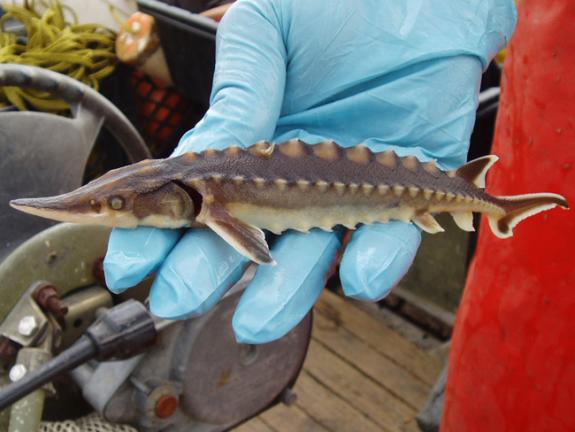Swam with Dinosaurs and Famed for Caviar, Atlantic Sturgeon at risk in New Jersey
Latest Podcast explores climate change threats to this ‘living fossil’
by Milena Bimpong

A ‘living fossil’ today swims the Delaware River, having survived eons from the days of the dinosaurs through the caviar craze a century ago that nearly wiped it out for its roe, or valuable eggs.
However, as explored in the latest episode of State of Change – Conserve Wildlife Foundation’s regular podcast exploring climate change impacts on New Jersey wildlife –the Atlantic sturgeon faces an abundance of modern threats.
From a historic population of 360,000 adults, “Based on our best estimates, there’s less than 300 in the river. There’s less than 1 tenth of 1% that was there historically,” says Dewayne Fox, a professor of fisheries at Delaware State University. “The loss of one or two adults is a significant loss of spawning potential in the Delaware River.”
Among the largest river fishes in North America, the Atlantic sturgeon can grow up to 14 feet and weigh up to 800 pounds. One sturgeon from New Jersey is believed to have been over 1,000 pounds. The Atlantic sturgeon’s features indicate that their existence can be traced back to millions of years.
Yet that lengthy run was in jeopardy after facing ensuing perils of caviar harvesting and pollution.

“We had this tremendous overharvesting for caviar at the turn of the 19th century, but at the same time then you started have the pollution inputs which also resulted in low dissolved oxygen levels in the river,” says Maya Van Rossum, the Delaware Riverkeeper. “In the Delaware River we had a 20-mile oxygen dead zone in the Philadelphia-Camden Riverfront. Over time that resulted in our Atlantic sturgeon population being brought to the brink of extinction.”
As anadromous fish, the Atlantic sturgeon spend their early years in freshwater environments and later migrate to marine environments. For reproduction, they return to freshwater environments. However, this is unlikely to occur for Atlantic Sturgeon in the New York Bight, which consists of the Delaware, Hudson, and Connecticut rivers. According to Fox, Atlantic sturgeon haven’t been moving between the Delaware and Hudson rivers due to reproductive isolation.
This means that sturgeon are far less suited for their environment after a slow recolonization. As a result of this reproductive isolation, the population of Atlantic sturgeon in the Delaware River has significantly decreased, to the extent that they may be at risk of extinction.
The podcast, hosted by CWF executive director David Wheeler and multimedia producer Matt Wozniak, explores solutions such as pollution reduction and mitigating vessel traffic, as well as saltwater intrusion caused by climate change. The future of the Atlantic sturgeon depends on the actions that are taken to protect their populations.
“There is no debating on whether the Atlantic sturgeon of the Delaware river is in dire straits. Now more than ever this species needs the support and cooperation of scientists, activists, and lawmakers. If we can’t work together to find solutions, the hundred million year run of the sturgeon could end in our lifetimes,” says Wheeler.
You can listen to the Atlantic sturgeon podcast and all CWF State of Change podcasts here.
Click here for CWF’s Atlantic sturgeon field guide.
More information on Delaware Riverkeeper can be found at https://www.delawareriverkeeper.org/.
More information about Delaware State University’s Natural Resources: Fisheries Management program can be found here.
Discover more from Conserve Wildlife Foundation of NJ
Subscribe to get the latest posts sent to your email.